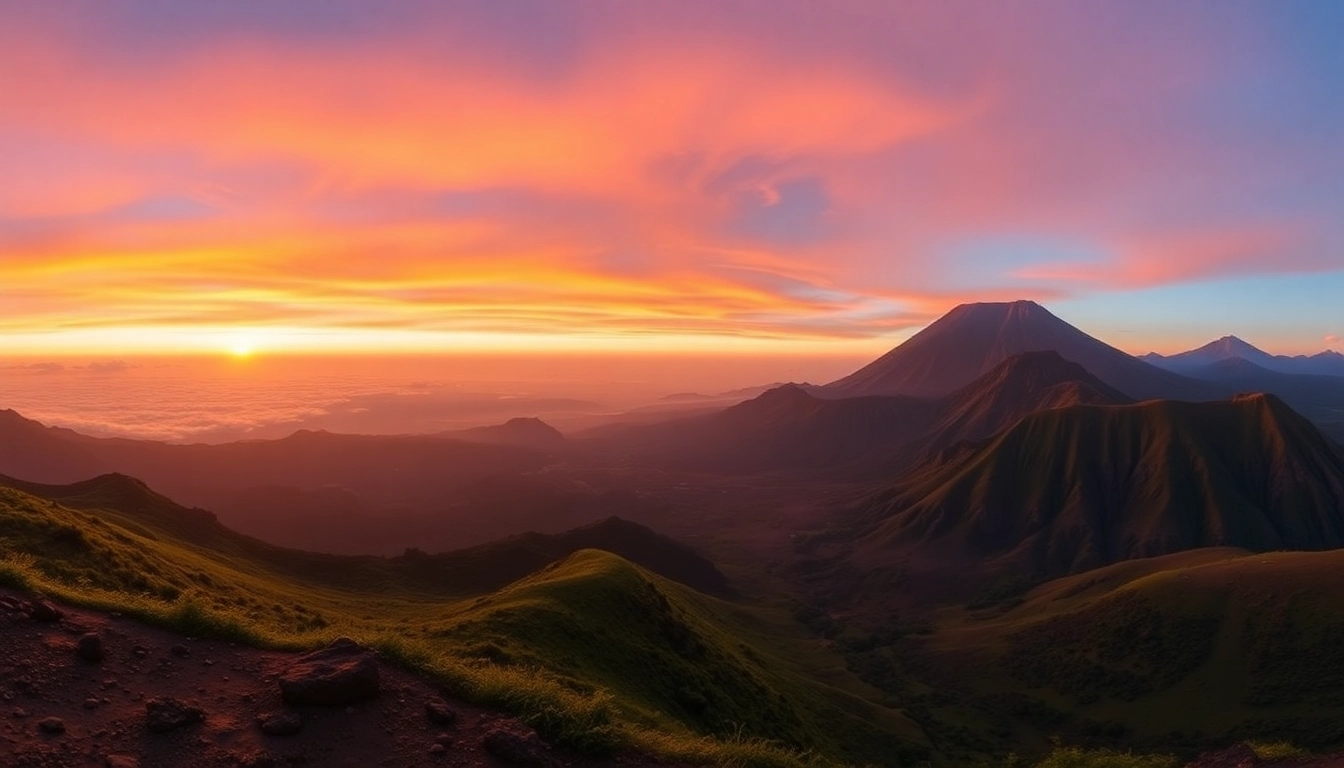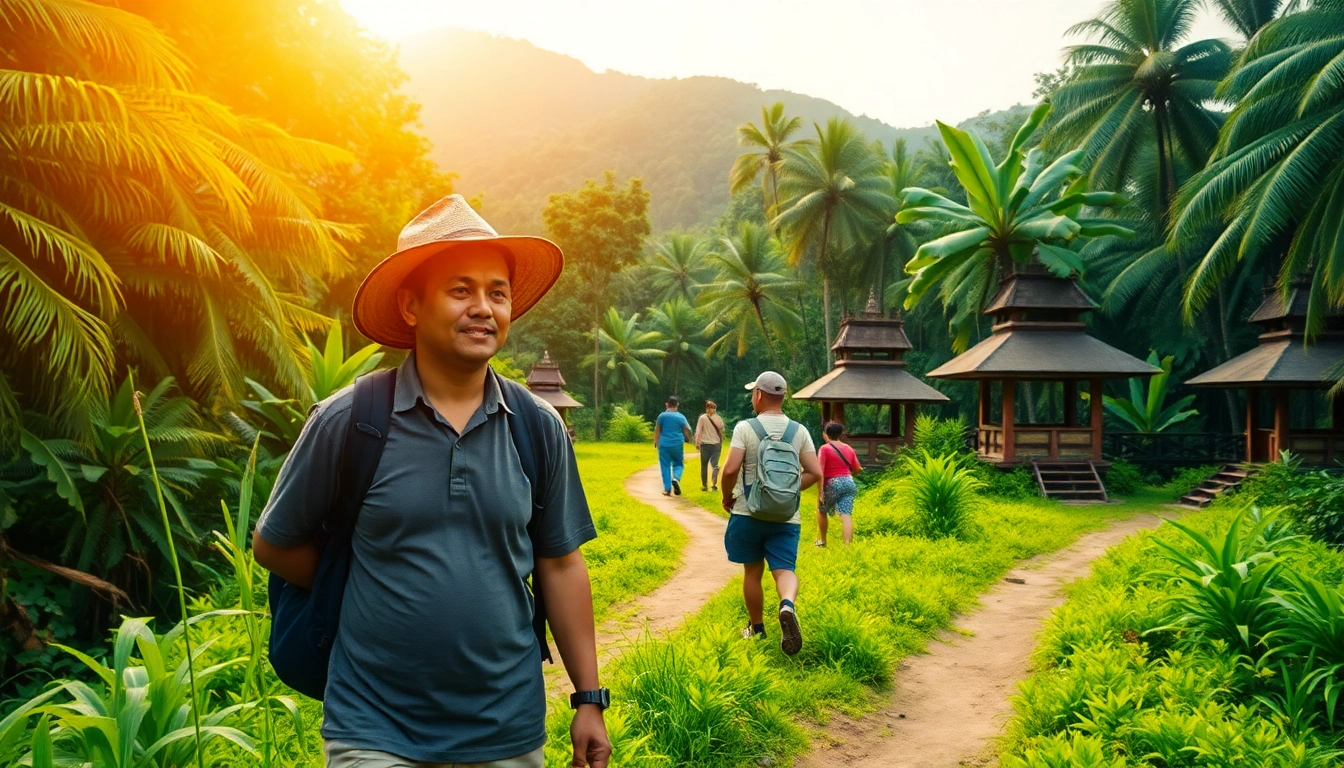Introduction to Mount Rinjani: Indonesia’s Second Highest Volcano
Nestled within the lush and diverse landscapes of Lombok, Indonesia, Mt. Rinjani stands as one of Southeast Asia’s most iconic and awe-inspiring volcanoes. Rising majestically to an elevation of 3,726 meters, it holds the title of Indonesia’s second-highest volcano after Kerinci. As an active stratovolcano situated within the boundaries of the Rinjani National Park, this colossal mountain is both a natural marvel and a cultural symbol, playing a vital role in local ecosystems, spiritual beliefs, and tourism. Its significance extends beyond mere geological interest—it serves as a beacon for adventure seekers, nature lovers, and conservationists alike, offering a unique blend of challenging climbs, stunning landscapes, and ecological richness.
Understanding the allure of Mount Rinjani begins with appreciating its geographical location and its status as a geological and cultural landmark. This comprehensive guide aims to explore every facet of Rinjani—from its volcanic history to the exhilarating trekking routes that attract thousands annually. We will delve into its ecological significance, safety considerations, and the local community efforts to promote sustainable tourism. Whether you are a seasoned trekker or an intrigued traveler, discovering what makes Mount Rinjani a must-visit destination can profoundly enhance your experience.
Geographical Location and Significance
Mount Rinjani is situated in the northern part of Lombok island, part of the West Nusa Tenggara province in Indonesia. As an active stratovolcano, it dominates the landscape with its impressive cone and caldera. The volcano is part of the larger Rinjani National Park, which covers over 41,000 hectares of rich biodiversity and diverse ecosystems.
Geographically, Rinjani acts as a vital geological feature that influences local climate patterns and water systems. Its prominence in the landscape contributes to the region’s rainfall distribution, supporting the lush forests and agricultural activities in surrounding villages. The volcano’s caldera, measuring approximately 80 square kilometers, contains several lakes, the most famous being Segara Anak, which is a deep, volcanic crater lake with mesmerizing blue waters and a mysterious aura.
The strategic importance of Rinjani extends into its role as a natural barrier and a cultural centerpiece. Local communities regard the mountain as sacred, integrating it into their spiritual practices, festivals, and daily lives. Moreover, its location within a major geological transition zone—part of the Wallacea biogeographical realm—makes it a crucial site for studies on volcanic activity, biodiversity, and climate change.
Historical Eruptions and Volcanic Activity
Mount Rinjani’s history is marked by numerous volcanic eruptions, some of which have dramatically reshaped the landscape and influenced regional developments. As an active volcano, Rinjani’s eruptions have ranged from gentle ash emissions to major explosive events, with the most recent significant activity recorded in December 2016, when authorities monitored increased seismic activity that temporarily restricted access for safety reasons.
The volcano’s first documented eruption dates back centuries, with records and oral histories outlining its volatile nature. The most notable eruption occurred around the 13th century, believed to have formed the current caldera structure. Historical data from geological surveys indicate eruptions predominantly occur every few decades, with the potential for future activity requiring ongoing monitoring.
The 2015 eruption phase saw ash plumes reaching up to 6 kilometers into the atmosphere, with lava flows and ash deposits surrounding the summit. These eruptions serve as a reminder of the mountain’s dynamic character and the importance of vigilant geological surveillance. Understanding Rinjani’s volcanic behavior helps mitigate risks for visitors and local inhabitants, emphasizing the need for comprehensive safety protocols and emergency preparedness plans.
Why Mount Rinjani Matters for Tourism and Environment
Mount Rinjani’s imposing stature and natural beauty make it a cornerstone of Lombok’s tourism industry. It attracts adventurers from around the world eager to challenge themselves on its rugged trails and witness the breathtaking vistas from its summit. Beyond climbing, Rinjani offers various eco-tourism opportunities, including trekking, hot springs, waterfalls, and birdwatching.
Environmental conservation is integral to Rinjani’s appeal. The region’s biodiversity, with endemic flora and fauna, is under threat from increasing tourism and climate change. Initiatives by local authorities and NGOs aim to balance tourist influx with ecological preservation by implementing sustainable practices, such as enforcing visitor guidelines, promoting eco-friendly accommodations, and supporting local conservation projects.
Ecologically, the park around Mount Rinjani is a transitional zone where Wallacean fauna meets Australasian species, resulting in a rich and diverse biosphere. Protecting these ecosystems ensures the sustainability of tourism, maintains biodiversity, and preserves the mountain’s cultural significance for future generations.
Climbing Mount Rinjani: Trekking Routes and Preparation
Popular Trekking Trails and Difficulty Levels
Mount Rinjani offers several trekking routes, catering to different experience levels and preferences. The most popular and accessible route is via Sembalun Lawang, renowned for its relatively gentle elevation gain and scenic vistas. This trail typically takes 3-4 days, covering approximately 27 kilometers, and challenges trekkers with a mix of alpine landscapes, volcanic terrain, and lush forests.
Alternatively, the Senaru route, originating from the village of Senaru, offers a slightly more strenuous ascent with varied terrain and gorge views. The Torean trail is less frequented but provides a more adventurous experience, traversing through diverse ecosystems and requiring higher endurance.
Difficulty levels vary from moderate to challenging depending on the selected route, altitude, weather conditions, and trekker experience. Proper planning and physical preparation are essential for a safe and enjoyable climb. Seasonally, the dry season from May to September presents the best conditions, with clearer skies and stable weather, reducing risks associated with rain or volcanic activity.
Guides, Permits, and Safety Tips for Climbers
Climbing Mount Rinjani is best undertaken with qualified local guides who are familiar with the terrain and potential hazards. Guided treks not only enhance safety but also support local communities economically. Permits are mandatory, issued by the Rinjani National Park authorities, and should be arranged beforehand or through authorized agencies.
Safety considerations include monitoring volcanic activity reports, preparing for sudden weather changes, and understanding evacuation procedures. Trekkers should adhere to park regulations, avoid straying from designated paths, and respect environmental guidelines to minimize ecological impact.
It’s advisable to carry a permit copy, trekking maps, communication devices, and familiarize oneself with local emergency contacts. Joining organized tours often ensures comprehensive safety protocols and access to porters and guides, easing physical demands and improving overall safety.
Essential Gear and Best Seasons for Trekking
Effective gear is crucial for a successful Rinjani trek. Essential items include sturdy hiking boots, layered clothing for changing weather, windproof and waterproof gear, warm sleeping bags, headlamps, and sufficient water and high-energy snacks. Technical equipment like trekking poles, GPS devices, and first aid kits are also recommended.
Choosing the right season significantly impacts the trekking experience. The dry season (May to September) offers the most favorable conditions, with less rain, stable temperatures, and clearer views. During the rainy season, trails can become slippery and dangerous, and access to certain areas may be restricted due to volcanic activity or weather concerns.
Preparation includes physical conditioning, acclimatization to high altitudes, and comprehensive packing. Engaging with local guides can provide tailored advice on current conditions and best practices, ensuring a safe and memorable adventure.
Discovering Rinjani National Park: Nature and Wildlife
Unique Flora and Fauna of the Park
The biodiversity within Rinjani National Park is remarkable. It features an array of ecosystems ranging from tropical rainforests at lower altitudes to alpine environments near the summit. The park is home to numerous endemic species, including the Rinjani scops owl, Lombok eared nightjar, and various reptiles and insects.
Vegetation varies from dense jungle with dipterocarps and ferns to alpine grasses and mosses. The diverse plant life supports a complex food web, attracting bird watchers and ecological researchers alike. Conservation efforts focus on protecting these habitats from illegal logging, encroachment, and the impacts of climate change.
Waterfalls, Hot Springs, and Other Natural Attractions
Beyond its volcanic summit, Rinjani hosts spectacular natural attractions that enrich visitors’ experiences. The Sindang Gila Waterfall cascade flows through lush surroundings, providing a refreshing stop during treks. The hot springs near Segara Anak lake offer a soothing remedy for tired muscles and a glimpse into the geothermal activity beneath the volcano.
The scenic crater lake, Segara Anak, is one of Rinjani’s most iconic features, with its turquoise waters nestled within the caldera. Additional spots include the Sendang Gila and Tiu Kelep waterfalls, accessible via short hikes, and the Gili Islands, which provide tranquil beaches and snorkeling opportunities nearby.
Conservation Efforts and Visitor Guidelines
Conservation is a shared responsibility among park authorities, local communities, and visitors. Initiatives aim to preserve the fragile ecosystems, prevent illegal activities, and promote sustainable tourism. Visitor guidelines emphasize leave-no-trace principles, proper waste disposal, and respecting wildlife habitats.
Local communities are actively involved in conservation programs, offering eco-friendly accommodations and cultural tours that benefit both conservation and local livelihoods. Promoting environmental awareness among trekkers and tourists ensures the long-term health of Rinjani’s ecosystems and enhances the natural experience for future visitors.
Planning Your Rinjani Adventure: Tips & Insights
Cost Estimates for Guides and Trekking Packages
The financial aspect of a Rinjani expedition includes guide fees, permits, equipment rental, and accommodations. Typical guide costs are around Rp. 350,000 per day (~$24 USD), with the full 4-day trek costing approximately Rp. 1,400,000 (~$96 USD). Porters available for hire can be priced at Rp. 300,000 daily (~$21 USD).
Full trekking packages, inclusive of permits, guide services, and basic gear, generally range from Rp. 3,000,000 to Rp. 5,000,000 (~$200–$350 USD), depending on the level of comfort and inclusions. It’s advisable to compare packages from reputable agencies, ensuring transparency and adherence to safety standards.
Travel Tips and Local Culture Insights
Arriving in Lombok typically involves flying into Lombok International Airport, followed by local transportation to starting points like Sembalun or Senaru. Respect for local customs and traditions enhances your experience—Lombok’s Sasak culture is rich with unique rituals, dances, and handicrafts.
Engaging with local guides not only enriches your trek with cultural narratives but also supports community development. Sample local cuisine, participate in traditional ceremonies when invited, and learn basic Bahasa Indonesia phrases to foster meaningful interactions.
Best Time to Visit and Environmental Considerations
The ideal window to visit Mount Rinjani is during the dry season, from May to September, when weather conditions are most stable. Avoid monsoon months (November to April), when heavy rains can cause trail closures and increase volcanic risks.
Environmental considerations include minimizing carbon footprint, avoiding single-use plastics, and supporting eco-friendly initiatives. Planning your visit during the shoulder months not only benefits safety but also helps reduce peak-season overcrowding, allowing for a more sustainable and intimate experience.
Safety and Environmental Responsibility on Rinjani
Managing Volcanic Risks and Respecting Nature
Active volcanoes demand careful risk management. Before embarking on your trek, always check for recent activity reports from the Smithsonian Global Volcanism Program and local authorities. Respect warning signs and avoid routes that are temporarily closed due to volcanic activity or weather hazards.
Adaptability and patience are key. If eruptions or ash clouds occur, participate in evacuations and follow guidance from park officials. Carrying safety gear, including masks and communication devices, can greatly enhance your safety, ensuring that adventures remain awe-inspiring rather than hazardous.
Leave No Trace Principles for Visitors
Preserving Rinjani’s pristine environment hinges on responsible tourism. Adhere to Leave No Trace principles: carry out all waste, minimize campfire impacts, stay on designated paths, and avoid disturbing wildlife. Respect cultural sites and local traditions to foster positive interactions with surrounding communities.
Volunteer participation in park cleanup initiatives and eco-awareness campaigns can further contribute to conservation. Educating fellow travelers ensures collective responsibility in maintaining the mountain’s natural beauty for generations to come.
Community Involvement and Sustainable Tourism Initiatives
Local communities surrounding Rinjani actively promote sustainable tourism through eco-lodges, guided treks, and cultural experiences that benefit residents directly. These initiatives focus on fair employment, cultural preservation, and environmental protection.
Supporting certified eco-friendly tour operators and choosing low-impact activities help reduce environmental degradation. By participating responsibly, visitors can play an integral role in sustaining the natural and cultural heritage of Mount Rinjani while enjoying an authentic and enriching experience.




